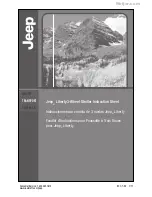
CHAPTER 5: SETTINGS
GROUPED ELEMENTS
N60 NETWORK STABILITY AND SYNCHROPHASOR MEASUREMENT SYSTEM – INSTRUCTION MANUAL
5-217
5
POWER SWING REV REACH
— This setting specifies the reverse reach of all three mho characteristics and the inner
quadrilateral characteristic. For a simple system of a line and two equivalent sources, this reach needs to be higher than
the positive-sequence impedance of the local source. Detailed transient stability studies can be needed for complex
systems to determine this setting. The angle of this reach impedance is specified by the
POWER SWING REV RCA
setting for
“Mho,” and the
POWER SWING FWD RCA
setting for inner “Quad.”
POWER SWING QUAD REV REACH MID
— This setting specifies the reverse reach of the middle quadrilateral characteristic.
The angle of this reach impedance is specified by the
POWER SWING FWD RCA
setting. The setting is not used if the shape
setting is “Mho.”
POWER SWING QUAD REV REACH OUT
— This setting specifies the reverse reach of the outer quadrilateral characteristic. The
angle of this reach impedance is specified by the
POWER SWING FWD RCA
setting. The setting is not used if the shape
setting is “Mho.”
POWER SWING REV RCA
— This setting specifies the angle of the reverse reach impedance for the mho characteristics. This
setting applies to mho shapes only.
POWER SWING OUTER LIMIT ANGLE
— This setting defines the outer power swing characteristic. The convention depicted in
the power swing detect mho operating characteristic diagram are to be observed: values greater than 90° result in an
apple-shaped characteristic; values less than 90° result in a lens-shaped characteristic. This angle must be selected in
consideration of the maximum expected load. If the maximum load angle is known, coordinate the outer limit angle with a
20° security margin. Detailed studies can be needed for complex systems to determine this setting. This setting applies to
mho shapes only.
POWER SWING MIDDLE LIMIT ANGLE
— This setting defines the middle power swing detect characteristic. It is relevant only
for the three-step mode. A typical value is close to the average of the outer and inner limit angles. This setting applies to
mho shapes only.
POWER SWING INNER LIMIT ANGLE
— This setting defines the inner power swing detect characteristic. The inner
characteristic is used by the out-of-step tripping function: beyond the inner characteristic out-of-step trip action is definite
(the actual trip can be delayed as per the
TRIP MODE
setting). Therefore, this angle must be selected in consideration to the
power swing angle beyond which the system becomes unstable and cannot recover.
The inner characteristic is also used by the power swing blocking function in the two-step mode. In this case, set this angle
large enough so that the characteristics of the distance elements are safely enclosed by the inner characteristic. This
setting applies to mho shapes only.
POWER SWING OUTER
,
MIDDLE
, and
INNER RGT BLD
— These settings specify the resistive reach of the right blinder. The
blinder applies to both “Mho” and “Quad” characteristics. Set these value high if no blinder is required for the “Mho”
characteristic.
POWER SWING OUTER
,
MIDDLE
, and
INNER LFT BLD
— These settings specify the resistive reach of the left blinder. Enter a
positive value; the relay automatically uses a negative value. The blinder applies to both “Mho” and “Quad” characteristics.
Set this value high if no blinder is required for the “Mho” characteristic.
POWER SWING PICKUP DELAY 1
— All the coordinating timers are related to each other and need to be set to detect the
fastest expected power swing and produce out-of-step tripping in a secure manner. Set the timers in relation to the power
swing detect characteristics, mode of power swing detect operation, and mode of out-of-step tripping. This timer defines
the interval that the impedance locus must spend between the outer and inner characteristics (two-step operating mode),
or between the outer and middle characteristics (three-step operating mode) before the power swing blocking signal is
established. This time delay must be set shorter than the time required for the impedance locus to travel between the two
selected characteristics during the fastest expected power swing. This setting is relevant for both power swing blocking
and out-of-step tripping.
POWER SWING RESET DELAY 1
— This setting defines the dropout delay for the power swing blocking signal. Detection of a
condition requiring a block output sets latch 1 after
PICKUP DELAY 1
time. When the impedance locus leaves the outer
characteristic, timer
POWER SWING RESET DELAY 1
is started. When the timer times-out, the latch is reset. Select this setting
to give extra security for the power swing blocking action.
POWER SWING PICKUP DELAY 2
— Controls the out-of-step tripping function in the three-step mode only. This timer defines
the interval the impedance locus must spend between the middle and inner characteristics before the second step of the
out-of-step tripping sequence is completed. This time delay must be set shorter than the time required for the impedance
locus to travel between the two characteristics during the fastest expected power swing.
















































